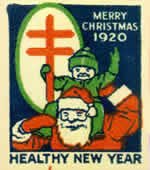
Editor’s Note: This is a story about love and charity. I want to use everyone’s hands to transmit positive energy.
One day in 1904, Jacob Riis, a well-known journalist in New York, received a letter from Copenhagen. Riis was a Danish immigrant. It was naturally common to receive such a letter. What was unusual was that there was another [stamp] besides the ordinary stamp on this letter.

An unusual [stamp]
This [stamp] looks ordinary, Apart from the Queen’s head, badges and flowers, Only the year [1904] and the word [Julen]. But it is obviously not a stamp, Because there is no postage on it. Out of the reporter’s keen sense of smell, Riis checked it out, It was found that this was not an ordinary stamp, But a special seal. Originally, Just one year ago, in 1903, Einar Hoboll, a Danish postal worker, came up with an idea to help children with tuberculosis. He said he could issue a non-postage [stamp] during Christmas. All the income will be used to build a children’s tuberculosis hospital. Buy one of these [stamps], It is equivalent to donating a sum of money, At the same time, people who have donated money can stick this special Christmas seal next to ordinary stamps, To tell you: I supported the construction of the Children’s Tuberculosis Hospital. With the support of the post office and the king, Hoboll’s next idea is to set the price of this Christmas seal at only two ores. equivalent to 0.02 Danish kroner, This price is affordable to everyone. In the first year, Denmark had sold 4 million Christmas envelopes. By the sixth year, Sufficient contributions have been raised, The Children’s Tuberculosis Hospital was finally officially opened in Kolding City in 1911. At that time, Tuberculosis is a problem not only in Denmark, It is a big problem all over the world. In the United States, 194 out of 100,000 people die of the disease every year, The U.S. Census Bureau estimated in 1908 that 202 people were second only to influenza and pneumonia. Tuberculosis accounts for 11 percent of all deaths, In New York alone, a quarter of children are infected. A large number of literary works are full of characters suffering from tuberculosis. Also because of this, Tuberculosis is known as the white plague. Riis himself, In 1904, Six brothers have also died of tuberculosis. In 1907, Riis published an article in Outlook magazine about the Christmas envelope, It introduced the story of the Danes. At that time, Public health care in the United States is basically conducted by private individuals. Especially at the end of the 19th century, Private charities began to emerge in large numbers. They vigorously promoted the construction of hospitals and medical schools. And launched a war epidemic against hookworm disease in the south, The threat of hookworm disease was finally eliminated. Riis said in the article, The rich are only the one percent. The remaining 99 percent cannot wait for the kindness of the rich. Ordinary people themselves have power. The Danish Christmas seal, It proves that although ordinary people have little income, But as long as everyone takes out a little, It can also produce great power. Riis believes that More importantly, It is through this collective behavior that people can, To point out the direction of social progress, Defining the next social problem to be solved. Riis then called for, We should also issue such [stamps], To conquer such serious diseases as tuberculosis. After this article was published, Emily Bissell, a woman who works in Outlook’s editorial department, read it naturally. Bissell also works for the Delaware Red Cross. At that time, The American Red Cross has no money, The impact is also very small. To be exact, There is not a decent one in the whole United States. Popularization, Rather than a charity that relies on a few donors. The Bissell lady immediately wanted to use a local tuberculosis sanatorium, which was cash-strapped. Why don’t you raise money for it in the same way? The target is $300. She found two friends and donated $40 as a book. He started selling his own Christmas seal. Bissell realized that selling this seal in a small place would not sell much. Just cross the Rubicon, She went to Philadelphia. She found The North American, a major local newspaper, and persuaded the owner of the newspaper to put a front-page publicity article for her. As a result, in the first year, Bissell sold more than $3,000 Christmas envelopes, ten times as many as expected. Ms Bissell’s success also inspired the Red Cross. The Red Cross also began issuing Christmas envelopes in national post offices the following year. The package reads:
Put this stamp and shining news into every Christmas letter. Help fight tuberculosis and make the new year better. These stamps cannot replace postage but can be pasted on any parcel.

Christmas Cover of 1908
In 1908, The Red Cross raised $135,000 with the Christmas seal, By 1909 it had risen to 250,000. By 1916, A total of more than $1 million was raised, Moreover, all buyers spent less than one dollar. The Red Cross has become a powerful public health organization. It also proves that the American people are fully capable of supporting large-scale public charities. At that time, it triggered the establishment of a number of local public charities. At that time, the American medical community was responsible for tuberculosis prevention and control. It is the National Association for the Study and Prevention of Tuberculosis. But this organization, established in 1904, does not have the economic strength of what. The Red Cross cooperated with the National Association for Tuberculosis Research and Prevention. Send the money you raise to support the National Association for Tuberculosis Research and Prevention, The number of members of the National Tuberculosis Association, From 5,000 to 500,000 in 1915, the number of tuberculosis clinics rose from 18 in 1914 to 455 in 1916. By 1919, the National Tuberculosis Research and Prevention Association was finally strong enough to maintain its own healthy operation and renamed itself the National Tuberculosis Association. The Red Cross officially transferred the exclusive ownership of the Christmas seal to the National Tuberculosis Association.


In 1919, the new Christmas cover, the red double cross, was the symbol of the National Tuberculosis Association.
The work of the Red Cross, Eventually, as Riis predicted, It also began to influence the decisions of the rich and politicians. In 1908, US President Theodore Roosevelt stepped in to support the Christmas seal. New York immediately passed the law. The Rockefeller Foundation finally joined the anti-TB campaign during World War I. And expand its work overseas. At the same time, The Red Cross itself has also been involved in round after round of charitable donations and relief campaigns. Growing bigger and stronger. As a result, from 1914 to 1918, The number of branches of the American Red Cross rose from 107 to 3,864, The number of members has also increased from 16,700 to more than 20 million. The Red Cross is also actively educating primary and secondary school students. Recruiting volunteers. In 1919, The Red Cross has more than 3 million small [crusaders], Popularize TB knowledge in the community. In 1917, In order to improve the inefficient organizational structure of the Red Cross, Transition to modern management, President Wilson personally appointed Henry Davison of JP Morgan to the Red Cross. In turn, As the operation of the Red Cross becomes more and more mature, It has also begun to intervene in all aspects of public health care and disaster relief in the United States. A large number of key talents have been trained for the U.S. Government. It fundamentally changed the pattern of American political life. Like Harry Hopkins, the main designer of Roosevelt’s New Deal, He was the chief executive of the Red Cross. By the 1960s, A total of 40 million copies of the Christmas envelope were sold, raising a total of 26 million US dollars. Famous people like Jacqueline Kennedy had promoted it. At this time, as the number of people infected with tuberculosis declined, the National Tuberculosis Association changed its name to the American Lung Association in 1973, and the income from the Christmas envelope was also used for lung-related topics.

2013 Christmas Cover
